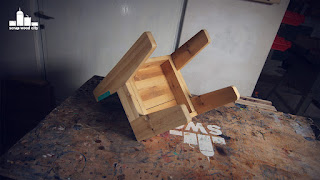Tools and materials I propose:
I wanted to make an acoustic string instrument using woodturning techniques as much as I could. I made this instrument out of basswood and iroko wood.
I begun by designing the body of my instrument. I then cut as much material as I could on the bandsaw and then mounted it on the lathe using a face plate.
Having the lathe running at it’s lowest speed, I rounded over the piece using a bowl gouge. I then Used a parting tools and a skew chisel to create a tenon so I can reverse chuck the piece on the lathe.
I then reversed the piece and started hollowing the inside like I would do on a regular bowl. I used the bowl gouge and a round scraper. Then I reversed the piece again. This time I used my bowl bottom cleaning jaws to remove the tenon.
Then I cut a piece of basswood to make the neck. I mounted it on the lathe between centers and trued it up using a roughing gouge. I also saved a piece to make the headstock later. Then I flattened one side of the cylinder using hand planes.
The neck and the body are connected with a dovetailed joint. I used a small saw and chisels to create both the male and female pieces. I then glued the neck and the body together.
Back on the lathe I used a spindle gouge and a round scraper to make the headstock. I then removed material on the bandsaw. I cleaned the saw marks with a hand plane.
Then it was time to make the joints for the head and neck. I used a small saw to make a side cut which I then cleaned on the belt sander. I used two small screws as center pins. Then I drilled holes on both pieces and added small bamboo sticks. The sticks prevent the pieces from moving around while glue up. Next I removed as much material as I could using a block plane.
At this point I decided to finish shaping the body, using files, chisels and my spokeshave.
I moved on my jointer in order to make the neck and the body flush and flat from the front side.
To make the top of the body I secured a pine piece on a melamine using double sided tape. Then I passed through the thickness planer to make it really thin. I then cut the top to shape on the bandsaw. I opened up a sound hole using a forstner bit. I then glued the under pieces of the top. Using a chisel I shaped the main brace of the top. Then I glued the top on the body. I then used the spokeshave, chisels and the belt sander to trim the top flush.
Next I squared a piece of iroko wood using the jointer / planer and the table saw. I then made the fretboard using the table saw and the belt sander.
My instrument measures 35,5cm from neck to bridge. So I visited an online fret calculator to find the fret positions. I then cut the fret slots. On my drill press I created the holes for the bamboo sticks. These sticks act as fret position indicators. Two of them will also prevent the fretboard from moving around while glue up. I then glued the fretboard and flush trimmed the fret position indicators. I pressed the frets in place using my vise as a press. I then added a drop of super glue to make sure the frets would stay in place. Using a file and a sanding block I trimmed the sides of the frets flush. I then leveled the frets with a sanding block. I polished them with steel wool. I also used a rotary tool with a buffing wheel to polish them even more.
It was now time to make the bridge. I placed two wood pieces on my pen jaws on the lathe. Then I used the skew to shape them. In the end I had two bridge bases. Using a mini chisel I made from an allen wrench I opened up the hole for the bone. I also used a regular chisel.
I wanted to make a four string instrument. So I cut my tuning pegs with a hacksaw. I removed any burrs on the grinder. I then drilled the holes for the tuning pegs on the headstock.
I finished my instrument with water based clear varnish. I finished the fretboard and the bridge with beeswax and mineral oil paste.
I then installed the string holder in place.
I made the bones for the bridge and nut out of plexiglass. I shaped them using sandpaper and files.
On the headstock I screwed a ring kind of piece as a string guide.
My little instrument was at this point ready.
Although in some cases turning the pieces was not that efficient, I think it worked. This proves to me again that the lathe is a really versatile tool.
Anyway, I really enjoyed this build. I hope you did so to. But that was it. See you soon with a new project video!
Disclosure: Some of the links below are affiliate links, meaning, that at no cost to you, I get a small commission if you click through and make a purchase.

































